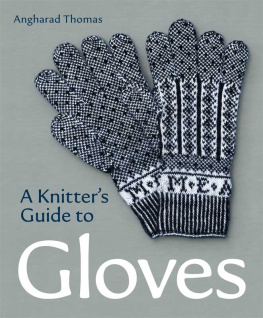PREFACE
Most men, apparently, take their gloves for granted. In these days the little refinements of civilization are accepted among us without a thought; but in so doing we lose a great deal of enjoyment which we never were intended to overlook. Least of all are our gloves commonplace. Mr. Chesterton has something to say about Tremendous Trifles. To my mind, he might have been talking about gloves. If you choose to think of them as trifles, then they are tremendous.
For thirty years I have devoted myself to the practical problems of the glove industry, and my connection with one of the substantial firms of master-merchant-glovers in the world has taught me how little gloves are known or appreciated by the millions of persons who buy them and wear them. The pursuit of glove lorethe historic romance of the glovehas long since been with me a selfish recreation. Now I desire to share it, as well as the practical knowledge, with all men and women who have missed seizing upon the real relation which gloves bear to life.
In the work of gathering together and arranging the material in this book, I wish to acknowledge my gratitude to Miss Marion Savage, who has collaborated faithfully with me, and has shared in no small degree my own enthusiasm for gloves, past and present.
WILLARD M. SMITH.
June, 1917.
Chapter I.
WHY GLOVES?
None other symbolthe cross exceptedhas so entered into the feelings and the affections of men, or so ruled and bound in integrity and right the transactions of life, as the glove.William S. Beck.
It is no unusual thing to meet American women who are connoisseurs of the hand-made laces brought to this country from abroad. Laces, like painting or sculpture, are an object of study; they have been raised to the level of the fine arts. But how often do we come across a womanit matters not how intelligent she may bewho has any real standards to guide her in the selection of gloves? Whether we have need, in a business sense, of expert knowledge on this subject or not, nearly everybody spends enough money yearly on this single detail of dress to be interested to know just what he is getting. Yet, there is scarcely any other department of merchandise with which the average person has so hasty and superficial an acquaintance. Nor is this by any means the laymans own fault entirely.
Let us look for a moment at the fabrics which go into the making of womens suits and gowns; shoes, mens shirts, carpets and furs: we recognize that all these long have been a matter of public education. Where is the woman who does not know the leading materials for coats and dresses? She may live far from the great commercial centres, but her womens magazine, published in New York, Philadelphia or Chicago, brings her descriptions by an expert, with colored, photographic reproductions, of the fashionable novelties. As for the experienced city shopper, if she were tested with her eyes shut, simply by touching the fabric she could identify it in most cases and could readily distinguish between goods of fine and inferior quality.
In the carpet department not infrequently a customer talks intelligently of three frame and six frame Brussels, or insists upon being shown hand-cut Wilton. Even the male shopper is not so indifferent in these days as not to know the names of the several varieties of fine cottons of which his shirts are made. He is aware of the difference between plain woven madras and crepe madras; he may prefer cotton cheviot, and will stipulate whether it shall be the Oxford or the basket weave. But if he be really fastidious, the chances are that he will demand soisette. In the last few years an amazing amount of style and seasonal variety have been introduced into shoes and furs. The result is that in these lines we feel obliged to be informed up to the minute. But, while fabrics and fashions in gloves constantly are changing, how much discrimination do most persons display in the selecting of this equally important item of apparel?
A well-dressed woman enters the glove department of a large shop on Fifth Avenue, New York. She may be an independent professional woman or she may be the wife or daughter of a man of means. In either case she should be concerned to know what value she receives for the money she spends. She asks for mocha gloves; but finding these rather more expensive than she had supposed, she may be persuaded to accept a sueded sheepskin under the misnomer of mocha, which substitutecould she but know itis a fraud, as even the finest suedes in point of durability are invariably inferior to, while they strikingly resemble, the Arabian mocha. The fallacy consists in her not being educated to know that it is the genuine mocha which she requires and for which she should be perfectly willing to pay. The unqualified superiority of real mocha to sueded sheepskin is worth every cent of the difference she would put into the purchase.
On the other hand, a man has been told that the only serviceable heavy glove for common wear is the cape glove. He insists, therefore, upon having the genuine capea name originally and properly used to designate gloves made of superior skins from the Cape district of South Africa. As a matter of fact, the soft, pliable, widely-worn glove in various weights, now commercially known as cape, is made from skins grown in many landsprincipally lamb, tanned and dressed by the napa dipped method. In consequence of having wool hide, these skins are not so tough as the Cape Hope goat with the hair hide. One pays less for them than for the real cape, but, for ordinary appearance, they are a fair substitute, and their wearing qualities undoubtedly meet the average requirement. A practical saving of this sort the public should be taught to appreciate.
But not for material reasons alone should gloves be given a prominent place in the curriculum of popular uplift. In the most obvious sense they are too little known, too vaguely appreciated, to be sure; and yet, the satisfaction of being well-gloved consists in something more than merely the delightful sensation of having ones hands neatly, warmly and substantially covered. We think of gloves first, no doubt, as a daily necessity. But we also value the finer qualities as a mark of elegance. Beautiful gloves impart the coup de grace to the formal costume of either man or woman. At the same time, clinging to this luxury, like a perfume of old, we are dimly conscious of an aura of half-forgotten associations, linking the glove with royalty, chivalry and romance; with famous affairs of honor, with the pomp and ceremonial of the Church, with countless dramatic episodes in history and literature.











